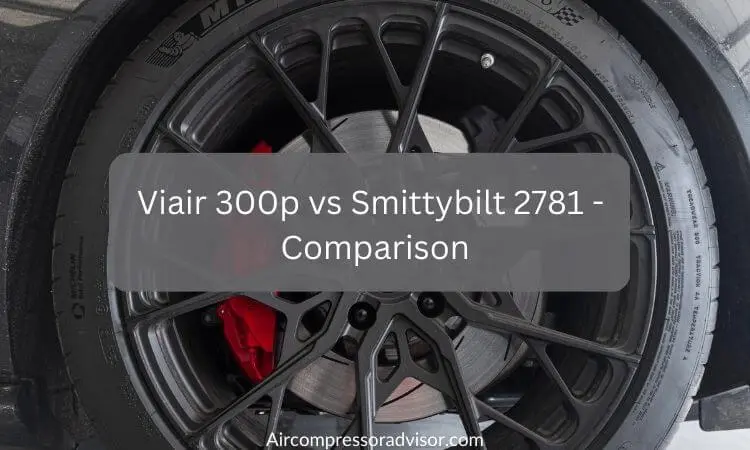Viair 300p vs Smittybilt 2781 - Side By Side Comparison

When it comes to choosing a portable air compressor, there are several factors to consider, such as size, weight, maximum pressure, duty cycle, airflow capacity, noise level, etc.
In this comparison, I will be comparing two air compressors that are VIAIR 300P and the Smittybilt (2781) explaining each of their features so you can make the right choice so without any further ado let's take a look at it.
Size and Weight:
The VIAIR 300P is a compact and lightweight air compressor, with a dimension of 9″ L x 4.9″ W x 7.5″ H and a weight of 8.70 lbs and has aluminum construction for durability. This makes it easy to store and transport especially, for outdoor activities such as camping, off-roading, or emergency situations.
On the other hand, the Smittybilt (2781) air compressor is larger and heavier, with a dimension of 16 x 12 x 11 inches and a weight of 21 pounds which makes it less portable than the viair 300p.
Maximum Pressure and Airflow Capacity:
The VIAIR 300P has a permanent magnetic motor with a maximum working pressure of 150 PSI and is capable of inflating up to 33-inch tires. It also has a capacity of 2.3 CFM, which means it can deliver a decent amount of airflow to inflate tires quickly and efficiently.
The Smittybilt (2781) air compressor, on the other hand, has a maximum airflow capacity of 5.65 CFM, which is significantly higher than the VIAIR 300P however, its maximum pressure is also the same as Viair 300p which is 150 PSI.
But it comes with a 0.33 horsepower oil-less direct drive motor and has an integrated 150 PSI pressure gauge whereas the Viair does not have it.
Duty Cycle and Safety Features:
The duty cycle of an air compressor refers to the amount of time it can run continuously without overheating or damaging the motor. The VIAIR 300P has a duty cycle of 33% @ 100 PSI whereas the Smittybilt (2781) air compressor has a duty cycle of 40 minutes at 40 PSI at 75 degrees Fahrenheit.
Additionally, the Smittybilt (2781) has an auto-thermal cutoff switch, which protects the motor from overheating, and a 30-amp inline fuse for added safety. The VIAIR 300P also has a thermal overload protector for overheating protection and a 40-amp inline fuse holder.
Noise Level and Accessories:
The noise level of an air compressor can be a crucial factor, especially if you plan to use it in a quiet or residential area.
The VIAIR 300P has a sound level of 73 dB which is relatively loud but still manageable and it also comes with an aluminum sand tray with vibration isolators which helps to reduce noise and vibration during use. This compressor includes a 25-foot air hose and an 8-foot power cord
The Smittybilt (2781) air compressor has a noise level of 70 dB, which is slightly quieter than the VIAIR 300P and it also has anti-rubber vibration feet for stability and comes with a 24-foot coil hose along with a 10-foot power cord.
Power Source and Connectivity:
Both air compressors are powered by a 12-volt corded electric source, which means they can be connected to a car battery or any other 12-volt power source.
However, the VIAIR 300P has a more convenient feature, which is the dual battery clamps that make it easy to connect to a car battery for power. The Smittybilt (2781) air compressor has heavy-duty easy clip connectors, which are a convenient feature that makes it easy to connect to other accessories.
VIAIR 300P Air Compressor:
Features List:
- Dimensions: 9″ L x 4.9″ W x 7.5″ H
- Weight: 8.70 lbs
- Max Working Pressure: 150 PSI
- Capacity: 2.3 CFM
- Material: Aluminum
- Voltage: 12 Volts
- Duty Cycle: 33% @ 100 PSI
- Power Source: Corded Electric
- Sound Level: 73 dB
- Max. Amp Draw: 30 Amps
- Permanent Magnetic Motor
- Dual Battery Clamps: Yes
- 40-Amp Inline Fuse Holder
- Air Hose Length: 25 ft
- Power Cord Length: 8 ft
- Thermal Overload Protector: Yes
- Aluminum Sand Tray With Vibration Isolators: Yes
Smittybilt (2781) Air Compressor:
Features List:
- Dimensions (LxWxH): 16 x 12 x 11 inches
- Weight: 21 Pounds
- Maximum Airflow: 150 Liters Per Minute
- Motor: 0.33 Horsepower Oil-less Direct Drive Motor
- Gauge: Integrated 150 PSI Pressure Gauge
- Air Flow Capacity: 5.65 CFM
- Voltage: 12 Volts
- Power Source: Corded Electric
- Noise Level: 70 dB
- 30 Amp Inline Fuse
- Duty Cycle: 40 Minutes At 40 PSI At 75 Degrees Fahrenheit
- Auto-Thermal Cut-Off Switch: Yes
- Hose: 24 Foot Coil Hose
- Power Cord: 10 ft
- Heavy-Duty Easy Clip Connectors
- Anti-Vibration Rubber Feet
Conclusion:
In summary, both air compressors are nice choices for you. The VIAIR 300P is more compact, lightweight, and suitable for home and light professional use, while the Smittybilt (2781) air compressor is larger, heavier, and has more CFM than the other model.
Both compressors have their advantages and drawbacks but ultimately your choice will depend on your specific needs, budget, as well as preferences and if you find this article helpful then share it with others and have a nice day.
Related Post: